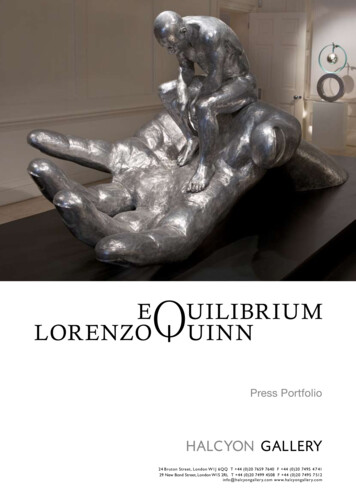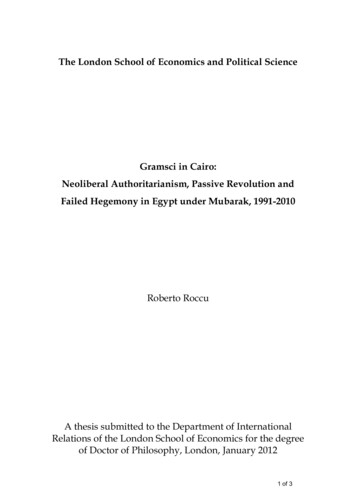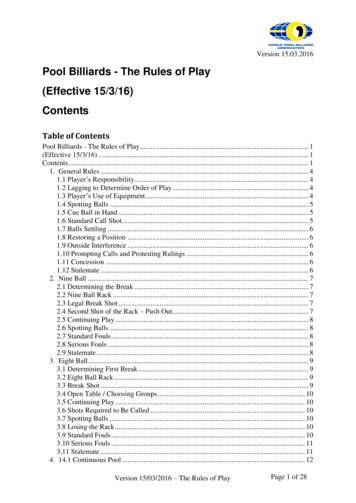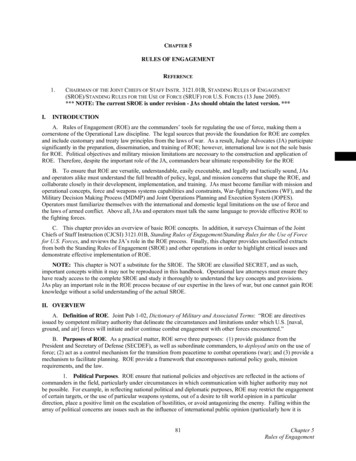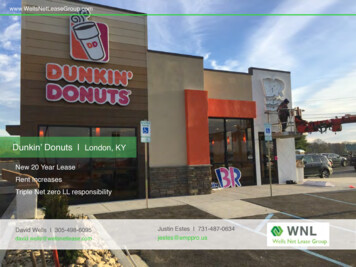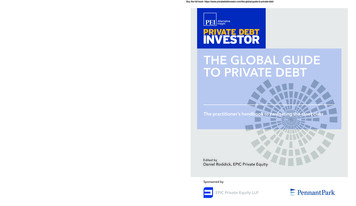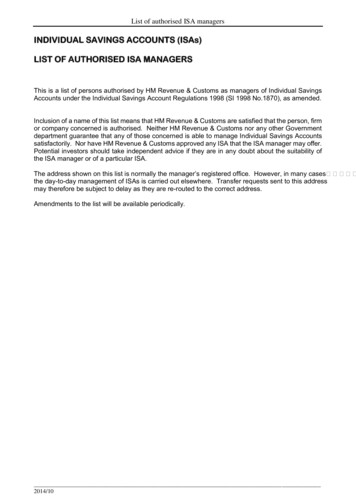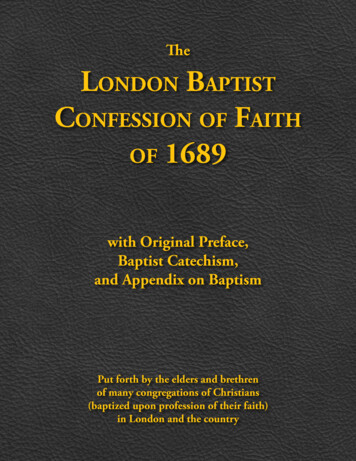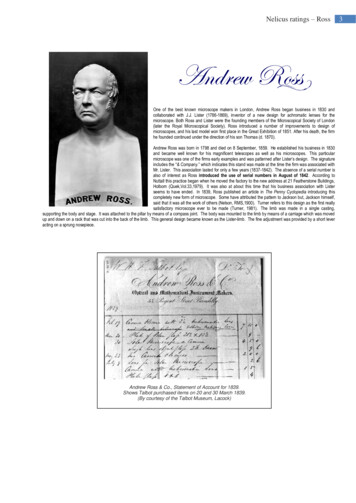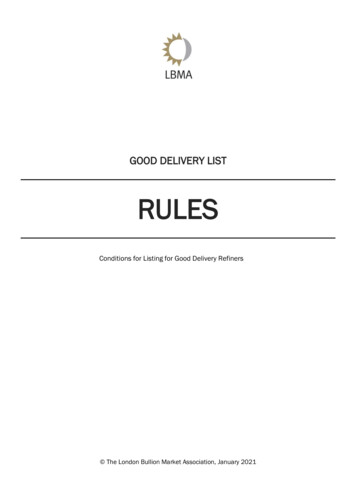
Transcription
GOOD DELIVERY LISTRULESConditions for Listing for Good Delivery Refiners The London Bullion Market Association, January 2021
ContentsDefinitions. 3SECTION 1 – BACKGROUND AND HIGH-LEVEL PRINCIPLES . 5SECTION 2 – TECHNICAL SPECIFICATIONS . 8SECTION 3 – QUALITY ASSURANCE . 14SECTION 4 – COMPLIANCE AND RISK MANAGEMENT . 17SECTION 5 – FURTHER INFORMATION AND COMPLAINTS . 19Annex A– Approved Weighers of Gold and Silver Bars . 20Annex B – Weighing, Packing and Delivery Procedures . 21Annex C – Weight lists . 25Annex D – Proactive Monitoring – Procedures and Criteria. 28Annex E – Specimen Technical Line Drawings . 33Annex F– Sample of End Stamping of Silver Bars . 35Annex G – Residual Elements . 36Annex H – LBMA and Good Delivery Brand Guidelines. 37Annex I – Incident Review Process. 392
DefinitionsApproved WeigherRefers to the list of weighers of gold and silver Bars whoseweighing facilities, procedures and capability meet thestandards required by LBMA.BarsBullion bars of approximately 400 fine troy ounces for gold andapproximately 1,000 troy ounces for silver.Executive CommitteeResponsible for reviewing work proposed/agreed by the Boardand its Sub-Committees to ensure the efficient running of LBMA.The Executive Committee is responsible for the followingconcerning the Good Delivery List: maintaining and developing the high standards of the GoodDelivery List; ensuring the Rulebook is kept up-to-date and fullyimplemented; reviewing issues identified and determining next steps; making final decisions regarding Good Delivery applicationsand status.Terms of Reference (TORs) for the Executive Committee, theBoard and its Sub-Committees are available on the LBMAwebsite.Former ListsLists of all Refiners and/or their Bars that have been removedfrom the List. The Former Lists include: Refiners who no longer produce Bars at the locations listed;whose bars are still considered Good Delivery prior to thedate of transfer to the Former List. Refiners whose Bars are no longer accepted as GoodDelivery by the London Bullion market; Assayer-only companies that were previously granted GoodDelivery status. Refiners are now required to have theability to assay as well as refine to the required standard.Good Delivery List orListsThe list of acceptable Refiners of gold and silver Bars in theLondon bullion market.Good Delivery or GDRefers to the status of Refiners or Bars listed by LBMA on theGood Delivery List.Physical CommitteeResponsible for monitoring, developing and protecting the GoodDelivery List. It also ensures that standards are maintained withemphasis on continuous improvement and transparency of themarket.RefereesReferees are Refiners appointed by LBMA to assist itsmaintenance of the Good Delivery System.3
Responsible SourcingProgramme or RSPEstablished for Good Delivery Refiners in order to combatabuses of human rights, to avoid contributing to conflict, and tocomply with high standards of anti-money laundering andcombating terrorist financing. This Programme formalises andconsolidates existing high standards of due diligence amongstGood Delivery Refiners.SupervisorsSupervisors in the Good Delivery system witness dip samplingand Bar casting operations for the Proactive MonitoringProgramme and to report on these to LBMA.Refers to a Market Making Member of LBMA which alsoprovides bullion vaulting and clearing services to third parties.Vaults4
SECTION 1 – BACKGROUND AND HIGH-LEVEL PRINCIPLES1.1 Background and Purpose1.1.1 BackgroundThe Good Delivery List (“GDL” or “List”) has been developed and is maintained by theLondon Bullion Market Association (“LBMA”). All refiners on this List are referred to as GoodDelivery Refiners (“Refiners”). This List facilitates the international distribution andacceptability of Bars produced by those Refiners.An entry on the List represents a Refiner at a specific location. Separate applications arerequired if an applicant wishes to register Bars produced by the same Refiner at differentlocations.The List is the copyright of LBMA. Reproduction and any dissemination of the List (in wholeor in part, in any form) is strictly prohibited without the express prior written consent of LBMAand any such use of the List by a Refiner must acknowledge LBMA’s copyright.1.1.2 PurposeThe purpose of this Rulebook is to clarify the requirements that all Refiners are expected tocomply with, both when applying to become accredited by LBMA and on an ongoing basis.This Rulebook comprises of:i.Principles that all Refiners must adhere to (Principles);ii.Technical Specifications rules;iii.Quality Assurance rules.(ii) and (iii) collectively referred to as the Rules.Each specific Rule (R), where appropriate, is followed by Guidance (G) to provide furtherclarification in support of the Rule. Failure to observe the Guidance can also potentiallyimpact a Refiner’s Good Delivery status.Breaching a Rule or Rules can potentially lead to removal from the List, as highlighted insection 1.4 (Enforcement).1.1.3 Changes to these RulesLBMA reserves the right to amend this Rulebook at any point. Any amendments will becommunicated in a timely way, and all Refiners will be provided with reasonable notice toimplement and comply with the amendments.1.2 PrinciplesThe Principles represent the overarching spirit of the Rulebook. Breaching a Principle canpotentially lead to removal from the List, as highlighted in section 1.4 (Enforcement).Principle 1 - Integrity: A Refiner must act with integrity, which includes adopting best practiceand responsible business practices.Principle 2 - Skill, care and diligence: A Refiner must conduct its business with due skill, careand diligence.Principle 3 - Management and control: A Refiner must take reasonable care to organise and5
control its affairs responsibly and effectively, with adequate risk management systems.Principle 4 - Financial prudence: A Refiner must maintain adequate financial resources andrecords.Principle 5 - Market conduct: A Refiner must observe proper standards of market conduct.1.3 Legal and Compliance1.3.1 Applicable LawsRefiners must comply with the laws, rules and regulations applicable to them and theprecious metals market in each jurisdiction in which they operate or transact (“ApplicableLaws”).Refiners are responsible for adopting their own internal policies and procedures designed tocomply with the Applicable Laws. In the event of a conflict between the Applicable Laws andthese Rules, Applicable Laws will prevail.LBMA recognises that Refiners may need to comply with national standards regarding theproduction of gold and silver Bars. To recognise such needs, LBMA attempts whereverpossible not to be overly prescriptive in formulating these Rules. It is for this reason thatsome provisions in this Rulebook appear as guidance on best practice and should beadopted unless prohibited by national standards.1.4 EnforcementA Refiner may be suspended from the GDL or ultimately removed and transferred to theFormer List if there is a persistent or serious breach of the Principles or Rules. The ExecutiveCommittee ultimately reserves the right to make this decision, at its discretion, following areview process.Examples of such breaches include but are not limited to: A Refiner changes ownership and the new owners are unable to provide satisfactoryevidence of their bona fides; A Refiner’s tangible net worth falls consistently below the minimum threshold; A Refiner’s production of refined metal falls consistently below the minimumthreshold specified; A Refiner fails to maintain the technical standards outlined in this Rulebook; If a Refiner ceases production or asks to be transferred to the Former List at its ownrequest; A Refiner does not respond adequately to justifiable customer complaints; A Refiner is subject to insolvency proceedings; A Refiner is subject to Criminal or Civil sanction(s) that LBMA believes could bringRefiner into disrepute or could cause reputational damage to LBMA; An event, circumstance, condition or change occurs, which materially and adverselyaffects, or could reasonably be expected to materially and adversely affect theRefiner’s business.If a Refiner is transferred to the Former List, the Bars that it produced while on the List will6
still be considered Good Delivery. LBMA reserves the right to de-list Bars after an appropriateperiod in cases where production has ceased.A previously-listed Bar (as defined by its dimensions and marks) may be transferred to theFormer List for one or more of the reasons listed below, while the Refiner continues to belisted but with a modified Bar: The form or dimensions of the Bar do not meet current requirements; The Bar’s marks or dimensions have been modified. For instance, a Refiner maychange the layout of the marks on its Bar from a portrait to a landscape format.Other reasons for such changes include rebranding by the Refiner (e.g. using a newlogo) or a change of ownership (e.g. a new name).Bars are listed at the discretion of the Executive Committee which reserves the right to makeany investigations that it deems appropriate into an applicant for listing.1.5 EscalationRefiners are expected, at the earliest opportunity possible, to inform the Chief TechnicalOfficer or Good Delivery List Officer (the GDL Team) if there has been a breach of any of theRules or Principles of this Rulebook. Failure to communicate a breach may have an impacton the Refiner’s Good Delivery status.7
SECTION 2 – TECHNICAL SPECIFICATIONSLBMA considers that the appearance of Bars is important, firstly because of the technicalreasons described below and secondly because the maintenance of high standards ofsurface finish indicates a good level of quality control in general. A poor Bar appearancemight, on the other hand, suggest that standards of refining or assaying are less thandesired.The decision on whether a Bar meets the physical standards of the London bullion market isthe responsibility of each Vault’s manager, who has complete discretion in relation to whichBars should be accepted. LBMA facilitates a consistent approach to such decision-making byarranging regular meetings of the Vault managers and by providing guidance to allow themto distinguish between, on the one hand, minor imperfections, and on the other, seriousdefects which require the Bar to be rejected.2.1 General Description of Good Delivery Bars2.1.1WeighingR Bars must be weighed as provided for in Annex B, and in accordance with the procedureset out Annex C.2.1.2Casting MethodR Bars must be produced in graphite or cast iron moulds, either by the: conventional method of pouring molten metal into them; or non-conventional method of melting grain in an induction tunnel system, or in thecase of silver, by continuous casting.Bars cast in open moulds should be produced at a single pouring.G Any Refiners wishing to convert to the use of the above-mentioned non-conventionalmethods of Bar production must submit a proposal to LBMA for consideration prior toimplementation. LBMA may then request that two Bars cast using the proposedalternative method must be sent to London for visual inspection. Once the Bar inspectionis complete, the Bars may then be sent to the Referees for further analysis to ensure thatthe Bars meet the specifications in these Rules. The Refiner must pay for LBMA’s costs inthe examination and testing of the Bars.2.1.3ShapeR Bars must be ingot-shaped (i.e., having a trapezoidal cross-section, both along the lengthand across the width of the Bar) with sufficient undercut to facilitate handling but withoutresulting in the width of the bottom surface being so narrow that the Bar cannot be safelystacked.G Bars must be easy and safe to handle. Refiners must ensure that their Bars will stacksafely when considering the dimensions of their proposed Bars. Proper stacking andhandling of a Bar will be taken into consideration during Bar inspections. It is importantthat the edges of the Bars must not be sharp, so to avoid the risk of injury duringhandling.8
2.1.4AppearanceR Refiners must make sure the following faults, especially on top surface of a Bar, areavoided: Irregularities such as surface cavities, cracks, holes or blisters (debris and watercan accumulate in such irregularities which can affect the weight of the Bar andaccumulated water can cause an explosion when the Bars are melted); Excessive shrinkage (i.e. the concavity of the top face of the Bar and anyconcentric cooling rings) must not significantly affect the clarity of the Bar marksor the safe stacking of the Bars; The sides and bottom (smaller) surface should be flat and reasonably smooth(which does not imply the need for a mirror-like finish) and free from cavities andlumps; Excessive layering, if it can result in dust or dirt being trapped and thus affectingthe recorded weight of a Bar.G Bars must be of good appearance. In the case of new production of gold Bars,hammering is not acceptable, nor are any attempts to conceal defects, for example byburnishing. In some cases, the use of a ball pein hammer to flatten a sharp protrusionmay be considered acceptable. In the case of silver Bars, it is recognised that a smalldegree of hammering or other surface treatment is sometimes required but suchhammering should not affect the markings or shape of the Bar.2.1.5MarksR All marks should include: stamp of the Refiner (which, if necessary for clear identification, should include itslocation); assay mark; fineness (Refiners must apply a consistent font to all digits); serial number (which must not comprise of more than 11 digits or characters); year and month of manufacture unless incorporated as the first digits in the Barnumber.All marks should be clear and the height of characters used for the fineness, the dateand the serial number should be a minimum of 12 mm.Gold Bars must be marked on the larger of the two main surfaces (the cast surface at thetop of the mould) using conventional (pressure) stamping or dot matrix (pneumaticpunching). If pneumatic punching is used, the marks must be no less clear and at leastas durable as if conventional stamping had been used.Silver Bars may alternatively be marked on the end of the Bar if marked using a dotmatrix method so that the marks can be read from the top edge downwards (see AnnexF).G Any Refiners intending to change to dot matrix marking should notify the GDL Team andsend a new drawing and photo in advance, together with the date from which the newmarking method will be used. Failure to provide this material in advance may result inBars being rejected on arrival at a Vault. For Refiners whose Bar dimensions are currently9
not compliant with LBMA’s recommended sizes, changing from pressure to dot-matrixmarking will trigger a requirement for Bars to be brought within the recommendeddimension range.If Bar numbers are to be reused each year, it is strongly recommended that the year ofproduction is shown as the first four digits of the Bar number although a separate fourdigit year stamp may be used in addition. If Bar numbers are not to be recycled eachyear, the year of production must be shown as a separate four-digit number.Since January 2019, Refiners must include the month of production in either two-digitform or a code (LBMA must be notified) the Bar serial number or year stamp (for example,January 2019 “0119”). Alternatively, Refiners must submit the last Bar number usedon the last day of each month to the GDL Team by email at gdl@lbma.org.uk.All Refiners added to the List after January 2019 must include in their Bar markings, thetwo-digit month stamp as outlined above.2.1.6Weight StampsR It is strongly recommended that weights should not be stamped on Bars, however if Barsare stamped in such a way, the unit of weight must be shown.G By way of background, when Bars are weighed by an Approved Weigher, their weights,which may be different from those determined by the original Refiner, will prevail. Inaddition, any change in the weight of a Bar caused by future handling or sampling wouldresult in a divergence between the weight-list weight and the marked weight.2.1.7Specifications for a Good Delivery BarAll Refiners must comply with the following specifications for Gold and Silver.Gold BarsRPhysical settlement of a loco London gold trade is a Bar conforming to the followingspecifications:Weight Minimum gold content: 350 fine troy ounces (approximately 10.9kilograms). Maximum gold content: 430 fine troy ounces (approximately 13.4kilograms).The gross weight of a Bar should be expressed in troy ounces, in multiples of 0.025,rounded down to the nearest 0.025 of a troy ounce.DimensionsThe permitted dimensional ranges for a gold Bar are as follows: Length (Top): 250 mm /- 40 mm Undercut: 5º to 25º. Width (Top):70 mm /- 15 mm Undercut: 5º to 25º.The undercut refers to the degree of slope on the side and ends of the Barand is represented by the angle of deviation from the vertical of the sideand end surfaces.10
Height:35 mm /- 10 mm.Fineness: the minimum acceptable fineness is 995.0 parts per thousand fine gold.Marks Serial number (see additional comments in Section 2.1.5 above). Stamp of the Refiner. Fineness (to four significant figures*). For Bars produced from January 2019 onwards, the year and month ofmanufacture (see additional comments in Section 2.1.5 above).*Since January 2018, gold and silver Bars can be marked with up to fivesignificant figures, if required by national standards. However, it must have apoint or comma delimiter to avoid confusion and potential ambiguous additions.The weight list would only include four significant figures.Silver BarsRThe physical settlement of a loco London silver trade is a Bar conforming to thefollowing specifications:Weight Minimum gross weight: 750 troy ounces (approximately 23 kilograms). Maximum gross weight: 1100 troy ounces (approximately 34 kilograms).It is recommended that Refiners should aim to produce Bars within the followingweight range: Minimum gross weight: 900 troy ounces (approximately 28 kilograms). Maximum gross weight: 1050 troy ounces (approximately 33 kilograms).Bars produced prior to 1 January 2008 having a weight in the former wider range of500 to 1250 troy ounces will continue to be acceptable, though it is expected thatthese will be phased out when the number of such Bars in the Vaults has declinedto nearly zero.The gross weight of a Bar should be expressed in troy ounces in multiples of 0.10,rounded down to the nearest 0.10 of a troy ounce.DimensionsThe permitted dimensional ranges for a silver Bar are as follows: Length (Top):300 mm /- 50 mm Undercut: 5º to 15º. Width (Top):130mm /- 20 mm Undercut: 5º to 15º. Height:80 mm /- 20 mm.Fineness: the minimum acceptable fineness is 999.0 parts per thousand silver.Marks Serial number (see additional comments in Section 2.1.5 above). Stamp of the Refiner.11
Fineness, expressed to either three or four significant figures*. Year of manufacture (see additional comments in Section 2.1.5 above).* Since January 2018, Bars can be marked with up to five significant figures, ifrequired by national standards. However, it must have a point or comma delimiter toavoid confusion and potential ambiguous additions. The weight list for theseinstances would only include four significant figures.2.2 Changes to Bar Dimensions or MarksRIf a Refiner wants to make changes to: The dimensions of its Bars; or The registered marks on its Bars,it must provide the GDL Team with at least one month’s notice of the change andprovide a technical line drawing of the proposed new Bar and the date on which it isintended to be introduced. All changes must be approved by LBMA before the Refinercan implement these changes.GAny change in a Refiner’s Bars will trigger a requirement for the new Bars to comply fullywith the specifications on markings and dimensions in of these Rules, and the Refinermust receive approval from LBMA before the changes are implemented. LBMA reservesthe right in such circumstances to reject any changes.Technical line drawings of the proposed new Bar should be submitted to LBMA forapproval. Once the drawings are approved and the new Bar is in production, the Refinermust send electronic images of the new Bar in plan and perspective views to the GDLTeam. See Annex E for a description of the required drawing and photographs.Failure to meet the above requirements will result in the rejection of any unapprovedmodified Bars for delivery into the London market and may result in the suspension orremoval of a Refiner from the List.The Bar dimensions set out above are mandatory for new Refiners. For Refiners alreadylisted whose Bars were first produced prior to January 2008 and are not within thesedimensions, their Bars will continue to be acceptable. However, if a Refiner wishes tochange either the dimensions or marks on the Bars, it must ensure that the new Barshave dimensions within the ranges specified. If a Refiner is only intending to change themarks without changing the dimensions, LBMA will allow it a grace period of six monthsto change the dimensions so that existing moulds can be used while new moulds areobtained.2.3 Non-Good Delivery BarsR If Bars do not meet the technical specifications set out in these Rules, the Refiner muststamp the Bars as NGD (meaning Non-Good Delivery) near the LBMA-approvedmanufacturer's mark.G This rules addresses Bars that are produced in the general form of Bars, but due to theirintended use (for example Bars produced for and delivered directly to an industrialcustomer for use as a raw material), they do not meet the Good Delivery technicalspecifications (for example, inferior appearance or sub-standard marks).12
2.4 Independent InspectionG If Bars are delivered into the London market and the recipient Vault believes that theBars do not conform to any of technical specifications in these Rules, the Vault may askLBMA to appoint independent inspectors to examine the Bars and express an opinion asto whether the Bars are acceptable for Good Delivery purposes.For the avoidance of doubt, any proposed recipient of Bars has, irrespective of any viewexpressed by an inspector on the condition of a Bar, the absolute right to refuse to acceptdelivery of a Bar if the Vault manager considers that the Bar does not meet the GoodDelivery standards as set out in these Rules.13
SECTION 3 – QUALITY ASSURANCEThe long-term viability of a Refiner and its ability to meet Good Delivery standards, especially inresponding to legitimate complaints about Bar quality, require it to have a minimum annualproduction volume and financial standing. In addition, Refiners should undergo continuousmonitoring of their production to ensure compliance the technical specifications set out in theseRules.Refiners must comply will all provisions set out in this section. Failure to do so may result in thesuspension or removal of a Refiner from the List.3.1 Throughput and Tangible Net Worth (TNW)3.1.1RGMinimum RequirementRefiners must comply with the following minimum Throughput and TNW requirements, orhave a letter of guarantee from the parent company, who will fully support and resolve anyproduction issue:Tangible net worth(TNW):The net financial value of a Refiner. All Refiners must have aminimum TNW of 15,000,000.Throughput:The annual refined production of a Refiner. The current minimumthresholds are 10 tonnes for gold and 50 tonnes for silver perannum.LBMA recognises that in any one financial year there may be temporary circumstanceswhich result in reduced Throughput or TNW data being submitted by a Refiner with theeffect that the Refiner fails to meet the requisite thresholds.As such, all annual data provided by a Refiner to LBMA will be reviewed on a three-yearmoving average basis which means that trends will be analysed over time. This willoperate with the consequences as follows:3.1.2 1 period (financial year) threshold Refiner placed on watch list; 2 consecutive periods threshold Refiner informed; 3 consecutive periods threshold Refiner must submit a remedial plan and failingto do so could result in the refiner being moved to the Former List.ReportingR Refiners must report their Throughput and audited TNW data to the GDL Team withinthree months of their financial year-end.G Refiners are subject to annual review based on reported Throughput and TNW data. Anyrequests for extension of this deadline will be dealt with on a case-by-case basis at thediscretion of LBMA.If a Refiner suffers a substantial and sustained fall in refined production volumes or itsTNW relative to the minimum thresholds, it must without delay inform LBMA of (i) thereasons for the fall and, if appropriate, the likely future figures; (ii) the steps being taken;and (iii) the anticipated timeframe for production volumes to return to prior levels.14
Failure to fully and promptly disclose the causes of any prolonged reduction inThroughput or TNW may result in the suspension or removal of a Refiner from the List.LBMA will only use Throughput and TNW data for the purpose of monitoring the viability ofa Refiner’s business. Such data will be treated in the strictest confidence and will not beshared with any third parties.3.2Corporate ChangesR A Refiner must inform the GDL Team at least one month in advance, providing allappropriate details, if it wishes to change: Location of its Refiner; Ownership or control (including group restructuring); Changes in processes.G LBMA reserves the right in such circumstances to ask the Refiner company to submit anew application.3.3 Proactive MonitoringR Refiners must comply with the Proactive Monitoring (PAM) Programme, as set out inAnnex D. On request, Refiners must provide a dip sample from a normal production melt,which will be check-assayed by one of the Referees.G A list of the Referees can be found on the LBMA website in the Good Delivery Rulessection.LBMA operates a programme of monitoring the quality of the production and assayingability of Refiners. A Refiner’s ability to cast GD Bars also needs to be demonstratedduring the PAM process, which takes place once every three years. A Refiner will receive aletter from LBMA instructing it to participate in the PAM process on or around the thirdanniversary of its first inclusion on the List.Evidence will need to be provided in either photographic or video form, which will bereviewed by the Supervisor and included in the Supervisor’s report. The list of Supervisorscan be found on the LBMA website in the Good Delivery Rules section.Exceptions may apply to Refiners who regularly supply the London bullion market or othersuch recognised physical markets.Special arrangements apply to gold Refiners which only produce and market “four-nines”gold (see Annex D).3.4 Retesting of BarsR On request from LBMA, Refiners, at their cost, must submit Bars for retesting.G LBMA may request a Refiner to send Bars to a Vault for inspection and testing if: a Refiner is unable to demonstrate the required competence in assaying, asrevealed under the PAM process; or if the appearance of a Refiner’s Bars gives cause for concern.15
Testing methodThe methods of inspection and testing specified in the Application process will generallybe followed.A Refiner is required to pay for the cost of insurance and shipping the Bars to the Vault. If asubsequent inspection by a panel of Vaults or other specialists appointed by LBMA issatisfactory, LBMA will charge the Refiner accordingly. However, should the Vault’sinspection indicate the need for further testing of the Bars by the Referees, an additionalcharge may be levied to cover the cost of shipping the Bars to the Referees and the testingof the Bars by the Referees. Current charges are available on the LBMA website.Refusal to participate in PAM or refusal to submit Bars for retesting will result in thesuspension or removal of a Refiner from the List.3.5 Annual Maintenance FeesR Refiners must pay a maintenance fee to LBMA within 30 days of the date of invoice.G Fees for a single or dual metal listing can be found on the LBMA website. Refiners will beinvoiced for their fee at the start of the calendar year.In case of late payment, the fee will be subject to a 20% surcharge.If a Refiner does not pay its fee within 90 days of the date of invoice, the Refiner will beimmediately suspended from the List and may be removed.16
SECTION 4 – COMPLIANCE AND RISK MANAGEMENTRefiners must have an effective governance framework that ensures accountability andoversight of a Refiner’s business. Refiners should also have a compliance and riskframework that provides for a robust control and compliance environment, which identifiesand ma
Delivery by the London Bullion market; Assayer-only companies that were previously granted Good Delivery status. Refiners are now required to have the ability to assay as well as refine to the required standard. Good Delivery List or Lists The list of acceptable Refiners of gold and silver
